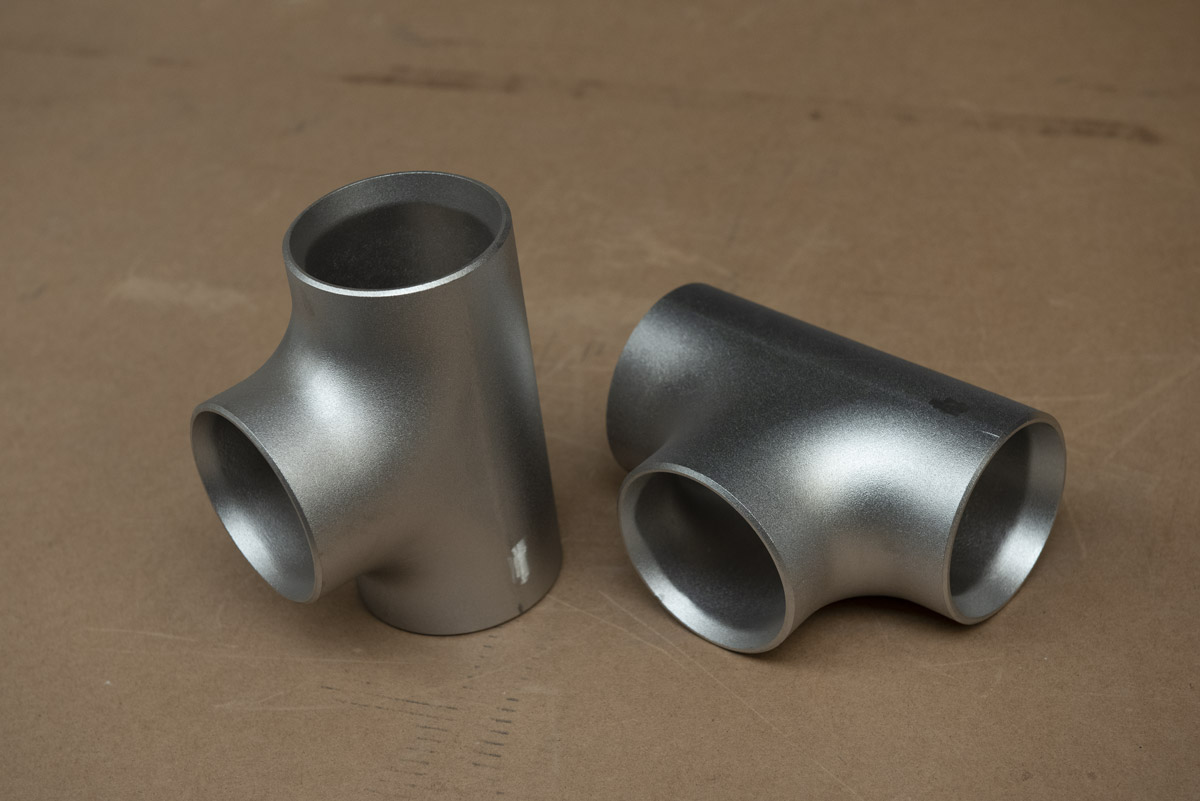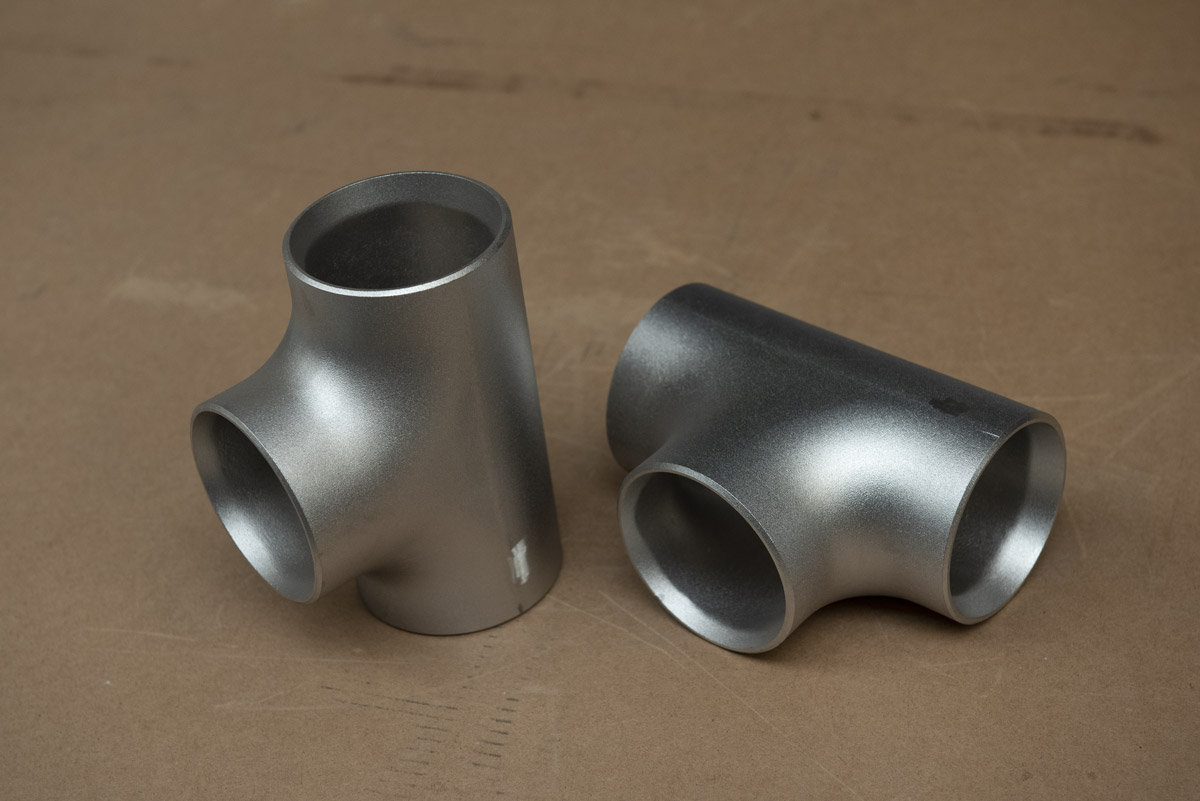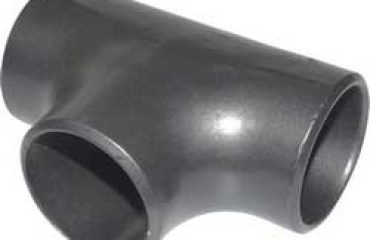
A234 WP11 alloy steel buttwelded pipe tee fittings are critical components in piping systems, particularly in industries requiring high-temperature and high-pressure resistance, such as oil and gas, petrochemical, power generation, and chemical processing. These fittings, compliant with ASTM A234 standards, are used in pipe spools—prefabricated sections of piping systems that include pipes, fittings, flanges, and valves, assembled in a controlled environment for efficient installation. The WP11 grade, a low-alloy steel with chromium and molybdenum, offers excellent creep resistance and strength at elevated temperatures, making it ideal for demanding applications.

-
Introduction to A234 WP11 Alloy Steel Buttwelded Pipe Tee Fittings
-
Key Parameters in Fabrication (with Tables)
-
Material Properties and Selection
-
Fabrication Processes and Technologies
-
Quality Assurance and Industry Standards
-
Applications and Case Studies
-
Environmental and Cost Considerations
-
SEO Keywords for Enhanced Visibility
-
Conclusion
-
Material: A234 WP11 is a chromium-molybdenum (Cr-Mo) alloy steel, typically containing 1–1.5% chromium and 0.44–0.65% molybdenum, enhancing strength and creep resistance.
-
Buttwelded Design: Fittings are welded to pipes using butt joints, ensuring a strong, leak-proof connection suitable for high-pressure systems.
-
Tee Configuration: Available as equal tees (same diameter for all branches) or reducing tees (different diameters), accommodating various piping layouts.
-
High-Temperature Performance: Suitable for temperatures up to 620°C, ideal for steam and hydrocarbon processing.
-
Creep Resistance: Enhanced by molybdenum, ensuring long-term reliability under sustained loads.
-
Strength: Offers high tensile and yield strength, supporting high-pressure applications (e.g., up to 6,000 psi).
-
Durability: Resistant to oxidation and moderate corrosion, extending service life.
-
Efficiency: Prefabrication in spools reduces on-site labor and improves installation accuracy.
-
Cost: Alloy steel is more expensive than carbon steel, and WP11 requires careful handling to maintain properties.
-
Welding Complexity: Requires precise welding techniques and post-weld heat treatment (PWHT) to prevent cracking.
-
Weight: Thick-walled fittings increase spool weight, complicating logistics.
|
Parameter
|
Description
|
Typical Values/Standards
|
Impact on Fabrication
|
|---|---|---|---|
|
Nominal Pipe Size (NPS)
|
Diameter of the tee fitting branches
|
1/2” to 48” (DN15 to DN1200)
|
Determines fitting size, weight, and welding requirements.
|
|
Wall Thickness
|
Thickness of the fitting walls
|
Sch 40, 80, 160, XXS; 5–50 mm
|
Affects pressure rating, welding difficulty, and material costs.
|
|
Material Grade
|
Alloy steel grade (WP11, Class 1 or 2)
|
ASTM A234 WP11 (1–1.5% Cr, 0.44–0.65% Mo)
|
Impacts strength, creep resistance, and weldability.
|
|
Weld Imperfection Criteria
|
Acceptable limits for weld imperfections (e.g., porosity, cracks)
|
ASME B31.3, ISO 5817, API 1104
|
Ensures structural integrity and compliance with standards.
|
|
Bevel Angle
|
Angle of fitting end preparation for welding
|
30°–37.5° (typically 37.5° for V-groove)
|
Affects weld penetration and strength.
|
|
Welding Process
|
Type of welding used (e.g., GTAW, SMAW, GMAW)
|
TIG (GTAW), Stick (SMAW), MIG (GMAW)
|
Determines weld quality, speed, and cost.
|
|
Fit-Up Tolerance
|
Alignment accuracy of fittings before welding
|
±1–2 mm (ASME B31.3)
|
Ensures proper joint alignment, minimizing stresses.
|
|
Hydrostatic Test Pressure
|
Pressure applied to test fitting integrity
|
1.5x design pressure (ASME B31.3)
|
Verifies fitting integrity under operating conditions.
|
|
Surface Finish
|
Surface treatment (e.g., shot blasting, coating)
|
Ra 3.2–12.5 µm (industrial applications)
|
Impacts corrosion resistance and fluid flow characteristics.
|
|
Dimensional Tolerance
|
Allowable deviation in fitting dimensions
|
±1.5 mm for alignment, ±3 mm for length (ASME B16.9)
|
Ensures compatibility with spool and field installation.
|
|
Post-Weld Heat Treatment (PWHT)
|
Heat treatment to relieve residual stresses
|
650–720°C for 1–2 hours (ASTM A234)
|
Reduces residual stresses and prevents cracking.
|
|
Non-Destructive Testing (NDT)
|
Methods to detect defects (e.g., RT, UT, MT)
|
Radiography, Ultrasonic, Magnetic Particle
|
Ensures weld and material integrity without damaging the fitting.
|
|
Fitting Weight
|
Weight of individual tee fittings
|
2 kg to 1,000 kg (depending on size and thickness)
|
Affects transportation, handling, and installation.
|
|
Corrosion Allowance
|
Additional wall thickness for corrosion
|
1–3 mm (environment-dependent)
|
Extends service life in corrosive environments.
|
|
Thermal Expansion
|
Material expansion under operating temperatures
|
12–14 µm/m·K (WP11 alloy steel)
|
Requires expansion joints or supports in high-temperature systems.
|
-
Nominal Pipe Size (NPS) and Wall Thickness:
-
NPS defines the fitting’s compatibility with the piping system, while wall thickness (e.g., Sch 80 or 160) ensures high-pressure resistance. For example, a 12-inch Sch 80 WP11 tee has a wall thickness of ~17.48 mm, suitable for pressures up to 4,000 psi.
-
Scientific Consideration: The hoop stress (
\sigma) is calculated as:
\sigma = \frac{P \cdot D}{2t}where (P) is internal pressure, (D) is outer diameter, and (t) is wall thickness. Thick walls reduce stress, enhancing safety.
-
-
Material Grade:
-
A234 WP11 (Class 1 or 2) contains 1–1.5% chromium and 0.44–0.65% molybdenum, improving creep resistance and oxidation resistance at temperatures up to 620°C. Class 2 offers higher strength due to stricter heat treatment requirements.
-
Scientific Consideration: Chromium forms a protective oxide layer, reducing oxidation rates to <0.05 mm/year at 500°C, while molybdenum enhances creep strength, calculated via the Larson-Miller parameter:LMP = T \cdot (C + \log t)where (T) is temperature (K), (t) is time (hours), and (C) is a constant (~20 for WP11).
-
-
Weld Imperfection Criteria:
-
Welds must comply with ASME B31.3 or ISO 5817, ensuring imperfections like cracks or porosity are within acceptable limits. NDT methods like radiography (RT) detect defects with 95% accuracy.
-
Scientific Consideration: Imperfections act as stress concentrators, reducing fatigue life. Acceptance criteria ensure welds withstand cyclic loading.
-
-
Bevel Angle and Fit-Up Tolerance:
-
A 37.5° bevel angle optimizes weld penetration, while fit-up tolerances of ±1–2 mm minimize misalignment stresses.
-
Scientific Consideration: Misalignment induces residual stresses, calculated as:\sigma_r = E \cdot \epsilon
where (E) is the modulus of elasticity (~200 GPa for WP11) and
\epsilonis strain due to misalignment.
-
-
Welding Process:
-
Gas Tungsten Arc Welding (GTAW/TIG) is preferred for root passes due to its precision, while Shielded Metal Arc Welding (SMAW) is used for fill passes. Matching filler metals (e.g., E8018-B2) ensure weld compatibility.
-
Scientific Consideration: Heat input ((Q)) is:Q = \frac{\text{Voltage} \cdot \text{Current} \cdot 60}{\text{Welding Speed (mm/min)}}Controlled heat input (1–2 kJ/mm) minimizes grain growth in the heat-affected zone (HAZ).
-
-
Post-Weld Heat Treatment (PWHT):
-
PWHT at 650–720°C for 1–2 hours relieves residual stresses and tempers the HAZ, preventing stress corrosion cracking.
-
Scientific Consideration: PWHT reduces hardness in the HAZ, improving toughness, measured via Charpy impact tests (e.g., >27 J at 0°C).
-
-
Hydrostatic Test Pressure:
-
Testing at 1.5x design pressure (per ASME B31.3) ensures fittings withstand operational conditions without leaks.
-
Scientific Consideration: The test validates weld and material integrity under stress, ensuring no plastic deformation.
-
|
Property
|
Value
|
Applications
|
Advantages
|
Limitations
|
|---|---|---|---|---|
|
Chemical Composition
|
1–1.5% Cr, 0.44–0.65% Mo, 0.05–0.15% C
|
Power plants, refineries
|
Enhances creep and oxidation resistance
|
Requires PWHT to prevent cracking
|
|
Yield Strength
|
205–275 MPa (Class 1), 275–415 MPa (Class 2)
|
High-pressure steam lines
|
High strength at elevated temperatures
|
Lower than high-alloy steels
|
|
Tensile Strength
|
415–585 MPa (Class 1), 485–655 MPa (Class 2)
|
Petrochemical processing
|
Supports heavy loads
|
Moderate corrosion resistance
|
|
Operating Temperature
|
Up to 620°C
|
Boiler systems, turbines
|
Excellent creep resistance
|
Limited to non-corrosive environments
|
|
Corrosion Resistance
|
Moderate (oxidation-resistant up to 600°C)
|
Non-aggressive fluids
|
Suitable for steam and hydrocarbons
|
Susceptible to chloride corrosion
|
|
Weldability
|
Good with proper filler and PWHT
|
Buttwelded piping systems
|
Strong welds with matching fillers
|
Risk of cracking without PWHT
|
-
Creep Resistance: Molybdenum stabilizes the microstructure, reducing creep rates to <0.01%/1,000 hours at 550°C, critical for long-term reliability.
-
Oxidation Resistance: Chromium forms a Cr₂O₃ layer, reducing oxidation rates to <0.05 mm/year at 500°C.
-
Mechanical Properties: The yield strength of WP11 Class 2 (~275 MPa at 20°C) supports high-pressure applications, calculated via:\sigma_y = \frac{F}{A}where (F) is the applied force and (A) is the cross-sectional area.
-
Weldability: Proper filler metals (e.g., E8018-B2) and PWHT prevent hydrogen-induced cracking, common in Cr-Mo steels.
-
Process: Tees are formed via hot forging, extrusion, or hydraulic bulging, ensuring uniform thickness and strength. For example, a seamless WP11 tee is forged from a heated billet and shaped under high pressure.
-
Equipment: Hydraulic presses, forging dies, heat treatment furnaces.
-
Advancements: Computer-controlled forging ensures ±0.5 mm dimensional accuracy.
-
Process: Fittings are cut to length and beveled for welding using plasma or oxy-fuel cutting.
-
Equipment: CNC plasma cutters, automated beveling machines.
-
Scientific Consideration: Controlled cutting minimizes HAZ, preserving material properties.
-
Process: GTAW is used for root passes, with SMAW or GMAW for fill passes. Matching fillers (e.g., E8018-B2) ensure weld strength.
-
Equipment: TIG welders, welding positioners, PWHT furnaces.
-
Scientific Consideration: Low heat input (1–2 kJ/mm) prevents excessive grain growth, calculated as:Q = \frac{\text{Voltage} \cdot \text{Current} \cdot 60}{\text{Welding Speed}}
-
Process: Fittings are aligned with pipes using jigs and laser-guided systems to meet tolerances.
-
Equipment: 3D laser scanners, alignment clamps.
-
Advancements: Laser scanning ensures ±0.5 mm alignment, reducing weld imperfections.
-
Process: NDT methods (e.g., RT, UT, MT) detect defects, while hydrostatic testing verifies integrity.
-
Equipment: Digital X-ray systems, ultrasonic flaw detectors, pressure testing rigs.
-
Advancements: Phased-array ultrasonic testing (PAUT) provides 3D defect mapping, improving accuracy by 20%.
-
ASTM A234: Specification for alloy steel fittings.
-
ASME B16.9: Dimensions and tolerances for wrought fittings.
-
ASME B31.3: Process piping design and fabrication.
-
ISO 5817: Weld imperfection quality levels.
-
Material Verification: Spectrometric analysis confirms composition (e.g., 1–1.5% Cr).
-
Weld Inspection: 100% RT or UT for critical welds, ensuring compliance with ISO 5817 Level B.
-
Dimensional Checks: Laser measurements verify tolerances (±1.5 mm).
-
Pressure Testing: Hydrostatic tests at 1.5x design pressure confirm integrity.
-
PWHT Verification: Hardness tests (e.g., <200 HB) ensure proper heat treatment.
-
Power Generation: Steam lines in coal, gas, and nuclear power plants.
-
Oil and Gas: Refinery piping for crude oil and gas processing.
-
Petrochemical: High-temperature chemical reactors and distillation units.
-
Industrial Boilers: High-pressure steam distribution systems.
-
Project: Fabrication of 300 A234 WP11 seamless spools with tee fittings for a 500 MW power plant.
-
Challenges:
-
Operating temperature of 580°C and pressure of 3,500 psi.
-
Creep resistance for 25-year service life.
-
Tight tolerances (±1 mm).
-
-
Solution:
-
Used WP11 Class 2 fittings with Sch 80 thickness.
-
Employed GTAW with E8018-B2 fillers and PWHT at 700°C.
-
Conducted 100% RT and hydrostatic testing at 5,250 psi.
-
-
Outcome: Spools met ASME B31.1 standards, with no failures after 3 years of operation.
-
Project: A234 WP11 spools for a hydrocracking unit handling high-temperature hydrocarbons.
-
Challenges:
-
Temperature of 550°C and pressure of 2,500 psi.
-
Moderate corrosion from sulfur compounds.
-
Six-month fabrication timeline.
-
-
Solution:
-
Used WP11 Class 1 fittings with 2 mm corrosion allowance.
-
Implemented SMAW with PWHT and 100% UT.
-
Applied anti-corrosion coatings.
-
-
Outcome: Delivered on time, with zero leaks during testing and operation.
-
Material Efficiency: CNC nesting reduces alloy steel waste by 10–15%.
-
Energy Consumption: PWHT and welding consume significant energy; inverter-based welders reduce usage by 15%.
-
Coatings: Low-VOC coatings minimize emissions.
-
Recycling: Alloy steel is 90% recyclable, reducing environmental impact.
-
Material Costs: WP11 is 1.5–2x more expensive than carbon steel, but its durability lowers lifecycle costs.
-
Fabrication Costs: PWHT and NDT increase costs, mitigated by automation (e.g., robotic welding reduces labor by 20%).
-
Optimization: Use BIM to minimize rework, standardize designs, and negotiate bulk material purchases.
Scientific Consideration: Cost optimization via linear programming:
where
is material cost,
is labor cost, and
is transportation cost.
-
Primary Keywords:
-
A234 WP11 pipe fittings
-
Alloy steel buttwelded tee
-
Piping spool fabrication
-
High-temperature pipe fittings
-
Chromium-molybdenum fittings
-
-
Technical Keywords:
-
ASME B16.9 alloy fittings
-
PWHT for WP11 fittings
-
NDT for buttwelded tees
-
Weld imperfection standards
-
Hydrostatic testing for tees
-
-
Material Keywords:
-
A234 WP11 alloy steel
-
Cr-Mo pipe fittings
-
WP11 Class 2 fittings
-
Low-alloy steel tees
-
-
Industry Keywords:
-
Power plant pipe fittings
-
Oil and gas piping systems
-
Petrochemical tee fittings
-
Boiler system fittings
-
-
Process Keywords:
-
GTAW welding for alloy fittings
-
Seamless tee manufacturing
-
CNC cutting for WP11 fittings
-
PAUT for weld inspection
-
-
Long-Tail Keywords:
-
How to fabricate A234 WP11 tee fittings
-
Best practices for alloy steel spool fabrication
-
WP11 fittings for high-pressure steam lines
-
Creep-resistant fittings for power plants
-
-
Sustainability Keywords:
-
Eco-friendly alloy steel fittings
-
Recyclable WP11 fittings
-
Sustainable piping fabrication
-
-
On-Page: Use keywords in headings, meta tags, and content.
-
Content Marketing: Publish blogs (e.g., “A234 WP11 Fittings for Power Plants”).
-
Backlinks: Partner with industry publications.
-
Local SEO: Include terms like “WP11 fittings USA” for targeted markets.



You must be logged in to post a comment.